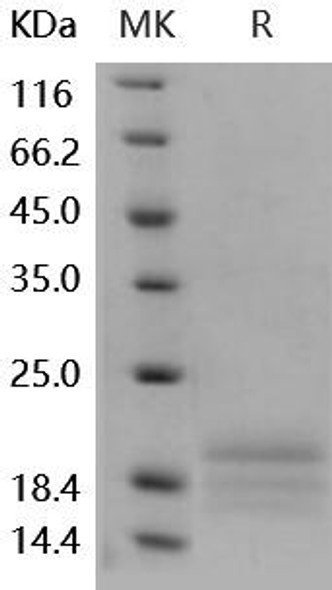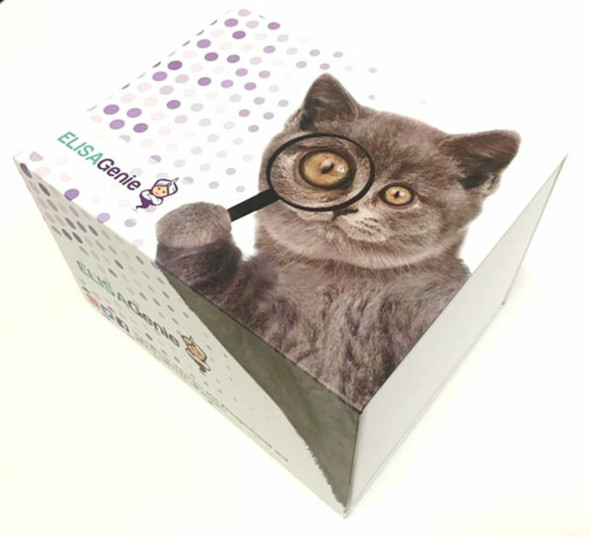Description
| Product Name: | Human AGRP Recombinant Protein |
| Product Code: | RPPB1267 |
| Size: | 10µg |
| Species: | Human |
| Target: | AGRP |
| Synonyms: | ART, AGRT, ASIP2, MGC118963, AGRP. |
| Source: | Escherichia Coli |
| Physical Appearance: | Sterile Filtered White lyophilized (freeze-dried) powder. |
| Formulation: | AGRP protein was lyophilized from 0.5mg/ml in 5mM TRIS, 25mM NaCl, pH 7.5. |
| Solubility: | Add deionized water to prepare a working stock solution of approximately 0.5mg/ml and let the lyophilized pellet dissolve completely. |
| Stability: | Store lyophilized AGRP protein at -20°C. Aliquot the product after reconstitution to avoid repeated freezing/thawing cycles. Reconstituted protein can be stored at 4°C for a limited period of time; it does not show any change after two weeks at 4°C. |
| Purity: | Purity of Agouti�related protein recombinant human is >95% as determined by SDS-PAGE. |
| Amino Acid Sequence: | MKHHHHHHHM LVPRGSAQMG LAPMEGIRRP DQALLPELPG LGLRAPLKKT TAEQAEEDLL QEAQALAEVL DLQDREPRSS RRCVRLHESC LGQQVPCCDP CATCYCRFFN AFCYCRKLGT AMNPCSRT |
Agouti-related protein is an endogenous antagonist of hypothalamic alpha-melanocortin receptors MC3R and MC4R with potent orexigenic activity. Although a complete deletion of the AGRP gene does not produce any significant metabolic phenotypes, reduction in AGRP expression by RNA interference is associated with increased metabolic rate along with reduced weight gain. In hypothalamus, it is produced by neurons in the medial portion of arcuate nucleus, which produce also the potent orexigenic peptide Neuropeptide Y (NP-Y). Another site of central AGRP production is the hypothalamic nucleus. AGRP encompasses 132 amino acid residues and its alpha-melanocortin inhibiting activity results in a 34 amino acid cystine knot domain within the C-terminal (87-132) portion of the protein. Both AGRP and NP-Y expression was shown to be suppressed by leptin. Central administration of AGRP induces hyperphagia and increased gain in body weight in rodents, but may also exert metabolic effects even when hyperphagia is prevented. In the absence of hyperphagia, intracerebralventricular administration of AGRP caused significant increases in plasma leptin and insulin concentrations (twofold and 1.5-fold, respectively) and fat pad mass.In the periphery, AGRP mRNA was found in adrenal glands, lung, testis, ovary, skeletal muscle and adipose tissue in humans or rodents. In the adrenals, it was shown that AGRP antagonizes glucosteroid production mediated by MC4R. AGRP could then modulate locally the functions of some peripheral tissues such as adrenals.In human and rat serum, detectable levels of AGRP-like activity were reported in the lower picogram range. The serum AGRP levels were elevated in obese humans compared to lean controls and increased with fasting in rats.
The Human Agouti-related protein is created as a recombinant protein with N-terminal fusion of His Tag.The Human Agouti-related protein His-Tagged Fusion Protein, produced in E. coli, is 14.4 kDa (calculated) protein containing 112 amino acid residues of the human AGRP and 16 additional amino acid residues - His Tag, thrombin cleavage site (highlighted).The AGRP is purified by proprietary chromatographic techniques.
| UniProt Protein Function: | AGRP: Plays a role in weight homeostasis. Involved in the control of feeding behavior through the central melanocortin system. Acts as alpha melanocyte-stimulating hormone antagonist by inhibiting cAMP production mediated by stimulation of melanocortin receptors within the hypothalamus and adrenal gland. Has very low activity with MC5R. Is an inverse agonist for MC3R and MC4R being able to suppress their constitutive activity. It promotes MC3R and MC4R endocytosis in an arrestin-dependent manner. Genetic variations in AGRP may be a cause of obesity (OBESITY). It is a condition characterized by an increase of body weight beyond the limitation of skeletal and physical requirements, as the result of excessive accumulation of body fat. |
| UniProt Protein Details: | Protein type:Secreted; Hormone; Secreted, signal peptide Chromosomal Location of Human Ortholog: 16q22 Cellular Component: extracellular space; cell soma; Golgi lumen Molecular Function:neuropeptide hormone activity; receptor binding Biological Process: maternal process involved in pregnancy; hormone-mediated signaling; eating behavior; neuropeptide signaling pathway; photoperiodism; feeding behavior; adult feeding behavior; response to insulin stimulus Disease: Obesity |
| NCBI Summary: | This gene encodes an antagonist of the melanocortin-3 and melanocortin-4 receptor. It appears to regulate hypothalamic control of feeding behavior via melanocortin receptor and/or intracellular calcium regulation, and thus plays a role in weight homeostasis. Mutations in this gene have been associated with late on-set obesity. [provided by RefSeq, Dec 2009] |
| UniProt Code: | O00253 |
| NCBI GenInfo Identifier: | 4501995 |
| NCBI Gene ID: | 181 |
| NCBI Accession: | NP_001129.1 |
| UniProt Secondary Accession: | O00253,O15459, Q2TBD9, |
| UniProt Related Accession: | O00253 |
| Molecular Weight: | |
| NCBI Full Name: | agouti-related protein |
| NCBI Synonym Full Names: | agouti related neuropeptide |
| NCBI Official Symbol: | AGRP�� |
| NCBI Official Synonym Symbols: | ART; AGRT; ASIP2�� |
| NCBI Protein Information: | agouti-related protein; agouti related protein homolog |
| UniProt Protein Name: | Agouti-related protein |
| Protein Family: | Agouti-related protein |
| UniProt Gene Name: | AGRP�� |
| UniProt Entry Name: | AGRP_HUMAN |








